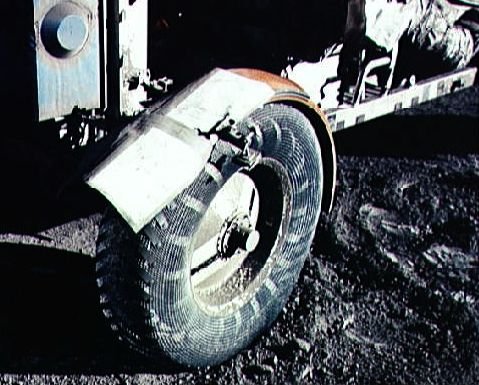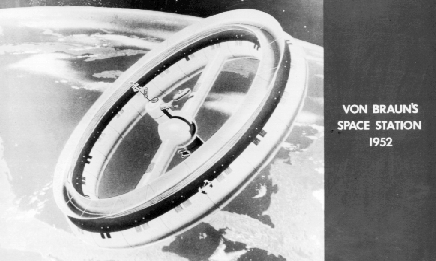#1010 Planetary Nebula NGC 7027 in Infrared March 25, 1998

“NGC 7027 is one of the smallest known planetary nebulae. Even so, NGC 7027 is 14,000 times larger than the Earth-Sun distance. Planetary nebula are so named because the first few discovered appeared similar to planets. Planetary nebula are actually dying stars, though, that have recently run out of nuclear fuel. The outer gaseous shells are expelled by an unknown process, frequently creating spectacular displays. In the above picture in infrared light, the hot central star is visible. Our Sun will become a planetary nebula in about 5 billion years."
Copyright: Public domain
#1011 Galaxies Away March 26, 1998

“This striking pair of galaxies is far, far away ... about 350 million light-years from Earth. Cataloged as AM0500-620, the pair is located in the southern constellation Dorado. The background elliptical and foreground spiral galaxy are representative of two of the three major classes of galaxies which inhabit our Universe. Within the disks of spiral galaxies, like our own Milky Way, gas, dust, and young blue star clusters trace out grand spiral "arms". The dust lanes along the arms of this particular spiral stand out dramatically in this Hubble Space Telescope image as they obligingly sweep in front of the background elliptical. Like the central bulges of spiral galaxies, elliptical galaxies tend toward spherical shapes resulting from more random motions of their stars. But while spirals produce new stars, star formation in ellipticals which lack gas and dust seems to have stopped. How do galaxies evolve with cosmic time? Evidence is growing that graceful galaxy shapes can hide a violent history."
Copyright: Public domain
#1012 Lunar Dust and Duct Tape March 27, 1998

“Why is the Moon dusty? On Earth, rocks are weathered by wind and water, creating soil and sand. On the Moon, the long history of micrometeorite bombardment has blasted away at the rocky surface creating a layer of powdery lunar soil or regolith. This lunar regolith could be a scientific and industrial bonanza. But for the Apollo astronauts and their equipment, the pervasive, fine, gritty dust was definitely a problem. On the lunar surface in December 1972, Apollo 17 astronauts Harrison Schmitt and Eugene Cernan needed to repair one of their lunar rover's fenders in an effort to keep the "rooster tails" of dust away from themselves and their gear. This picture reveals the wheel and fender of their dust covered rover along with the ingenious application of spare maps, clamps, and a grey strip of "duct tape"."
Copyright: Public domain
#1013 Von Braun's Wheel March 28, 1998

“Orbiting 1,075 miles above the Earth, a 250 foot wide, inflated, reinforced nylon "wheel" was conceived in the early 1950s to function as a navigational aid, meteorological station, military platform, and way station for space exploration by rocket pioneer Wernher von Braun. The wheel-shaped station could be easily rotated creating artificial gravity so that the astronauts would not suffer the effects of prolonged weightlessness. Von Braun and his team favored building a permanently occupied Earth orbiting space station from which to stage a lunar exploration program. But in the 1960s NASA adopted the Apollo Program, which called for astronauts to transfer to a landing vehicle after achieving lunar orbit, bypassing the construction of von Braun's wheel."
Copyright: Public domain
#1014 NGC 3293: A Bright Young Open Cluster March 29, 1998

“Hot blue stars shine brightly in this beautiful, recently formed galactic or "open" star cluster. Open cluster NGC 3293 is located in the constellation Carina, lies at a distance of about 8000 light years, and has a particularly high abundance of these young bright stars. A study of NGC 3293 implies that the blue stars are only about 6 million years old, whereas the cluster's dimmer, redder stars appear to be about 20 million years old. If true, star formation in this open cluster took at least 15 million years. Even this amount of time is short, however, when compared with the billions of years stars like our Sun live, and the over-ten billion year lifetimes of many galaxies and our universe. NGC 3293 appears just in front dense dust lane emanating from the Carina Nebula."
Copyright: Anglo-Australian Telescope
Board
#1015 A Bulls-Eye Einstein Ring March 30, 1998

“Can one galaxy hide behind another? Not in the case of B1938+666. Here the foreground galaxy acts like a huge gravitational lens, pulling the light from the background object around it, keeping it visible. Here the alignment is so precise that the distant galaxy is distorted into a nearly perfect giant ring around the foreground galaxy, a formation known as an Einstein ring. The bright peak at the center of the bulls-eye is the nearer galaxy. The cosmic mirage was found initially with the MERLIN radio telescope array. The follow-up image shown above from the Hubble Space Telescope was released earlier today. Although appearing extremely small at 1 arcsecond diameter, the above Einstein ring is really tens of thousands of light years across."
Copyright: Public domain
#1016 M20: The Trifid Nebula March 31, 1998

“Unspeakable beauty and unimaginable bedlam can be found together in the Trifid Nebula. Also known as M20, this photogenic nebula is visible with good binoculars in the constellation of Sagittarius. The energetic processes of star formation create not only the colors but the chaos. The red-glowing gas results from high-energy light striking interstellar hydrogen gas. The dark dust filaments that lace M20 were created in the atmospheres of cool giant stars and in the debris from supernovae explosions. Which bright young star lights up the blue reflection nebula is still being investigated. The light from M20 we see today left perhaps 3000 years ago. Light takes about 50 years to cross M20."
Copyright: Anglo-Australian Telescope
Board
#1017 Astronaut Kicks Lunar Field Goal April 01, 1998

“Score three points for NASA. With time running out late in Apollo 15's mission to the Moon in 1971, Astronaut David Scott prepared to "split the uprights" and bring about yet another dramatic end-of-the-mission win for NASA. Scott used a special "lunar football" designed for the rugged games held on the Moon. R1D1, a predecessor to R2D2, cheers from the sideline. Happy April Fools Day from the folks at APOD. In reality, Astronaut Scott adjusts one of Apollo 15's lunar experiments. The foreground device actually measured high-energy particles that escape from the Sun."
Copyright: Public domain
#1018 Iridium Flare April 02, 1998

“Have you seen an Iridium flare? Satellites in low Earth orbit reflect sunlight and are often visible gliding across early evening and predawn skies. But sun glints from Iridium commercial digital communications satellites are providing the most spectacular sightings. This Iridium flare photographed on September 20, 1997 by Belgian amateur astronomer Chris Dorreman reached an impressive -8 magnitude (about as bright as the half illuminated Moon). The one minute long exposure shows star trails nearly perpendicular to the bright, flaring track of the satellite and a "ghost" image of the flare at the far right. Iridium is the 77th element and so was a good name for the originally intended constellation of 77 satellites. Subsequently, plans were scaled down to 66 satellites with about 51 now in orbit and glinting away. Typical flares last 10 to 20 seconds. When can you catch a flare? The brightness, timing, and direction of a flare depend critically on your longitude and latitude, but satellite observers can make accurate predictions days in advance."
Copyright: Chris Dorreman
Upvote! Resteem! Comment! As you like it! Thank you for attention!
Resteemed to over 6000 followers and 100% upvoted. Thank you for using my service!
Send 0.100 Steem or 0.100 Steem Dollar and the URL in the memo to use the bot.
Read here how the bot from Berlin works.
@resteem.bot
Downvoting a post can decrease pending rewards and make it less visible. Common reasons:
Submit